Kitchen Hoods and Why They Matter
I've had some people ask for my opinion on hoods, lately, and of course I have a lot of opinions. So here we go.
First of all, hoods are mandatory by code in all of the US. I get pushback on this all the time, because hoods are not pretty, but this is to protect your home. Cooking on a stovetop produces a lot of water vapour and airborne oils and you need to get that out of your house rather than just leave it floating around to cause mold problems.
As for recirculating hoods, they are garbage. Hoods need to vent to the outdoors, preferably at the roof height where smells will not linger around the house.
So how do hoods work? This is an area where people have a lot of misconceptions: the idea most people seem to have is that the hood has a powerful fan that sucks up all the air and vents it outside. This is totally, completely incorrect. Hoods have moderately sized fans that can clear a bit of air right next to them, but most hoods have a very limited reach. The way they make up for that is with the mantle of the hood, which collects and gathers the vapours and holds them while the fan does its work.
This is why downdraft vents (I am not going to dignify them with the name "hood") are so incredibly ineffective.
A big consideration is that vapours that come off a hot pot or pan gets spread around by air currents and entropy, so the hood needs to be both close to the source of those vapours (most hoods have a recommended maximum height above the stove of about 28-30") and in general it should be sized a little larger than the top of the stove. This sizing allows more vapours to get trapped in the mantle and exhausted by the fans.
Want some illustrations?
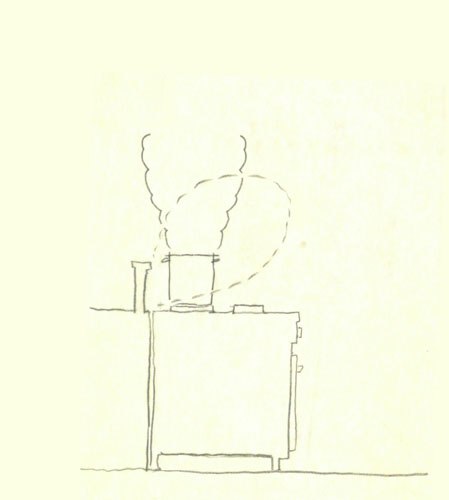
Here's how a downdraft vent works with a tall stock pot, which is to say, not at all. That dashed line is the effective area for the fan, where it can pull in vapours with any kind of effectiveness.
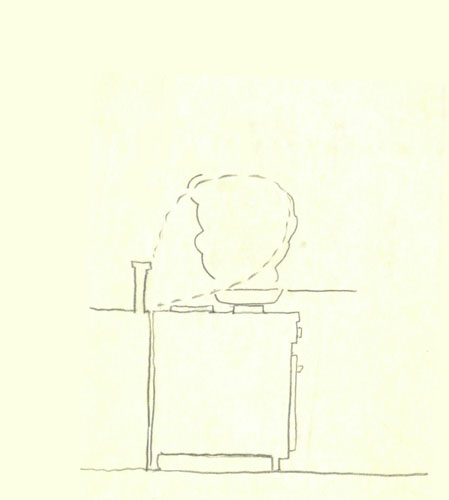
Downdrafts are even less effective when you are using the front burners, as you do for most high-heat sauteing and so on. In the best case, there is nothing else on the stove to block the air flow, and you get super lucky and there isn't an air current to push the column of vapours away from the vent.
Gah, I cannot express how much I dislike these things. I can think of only a few cases where they make any sense at all and none of them involve centrally located islands in modern homes.
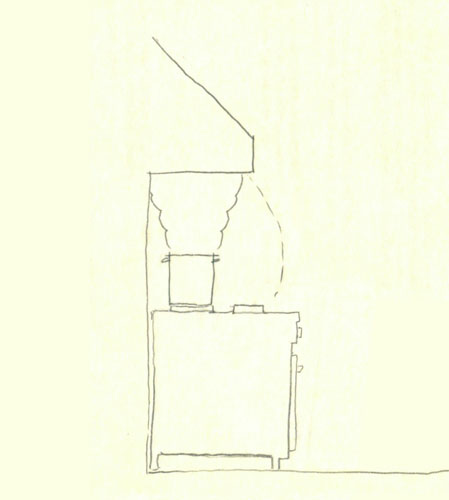
Here's an undersized hood from the side. In this case the stock pot has to be on the back burner if you don't want to fill your home with moisture. Trust me, we had friends over and made marmalade yesterday and our undersized hood over the rental stove could not keep up, so the windows in every room of the house had condensation on them this morning.
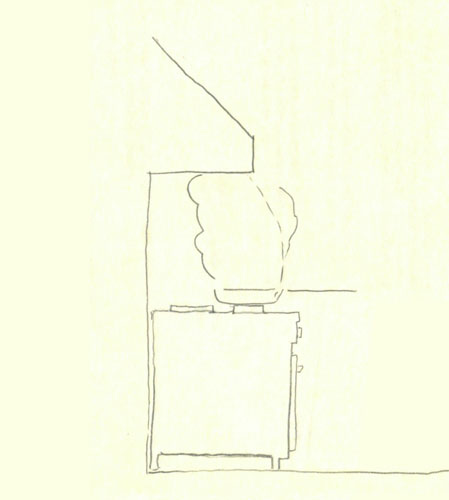
Undersized hoods are, again, an issue with using the front burners. I have clients who want an undersized hood because they are tall and don't want to hit their head, but I still recommend against it.
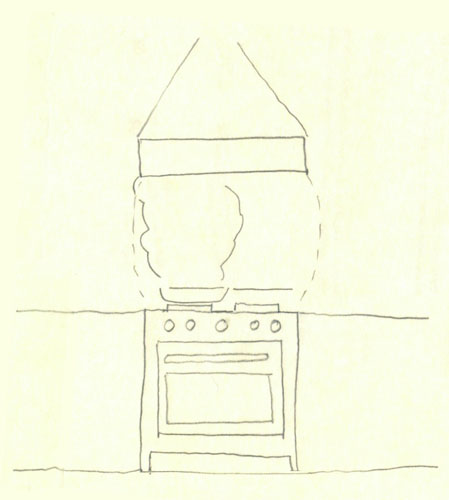
Here's a hood that is just as wide as the range. This is for many cooktops an undersized hood. Most of the commercial-style heavy duty stove makers recommend a hood that is 6" larger than the stove, so a 36" stove should have a 42" hood over it. But they don't line up neatly, so designers don't like to draw them that way.
My take on it is this: if you are not a power cooker, if you don't grill on your stove or use all the burners at once regularly, then you can go undersized on your hood width. Stay at full depth, but there's some leeway on width. If you do the kind of cooking we do, where we spend a week making all the tomato sauce we are going to eat for the year, or make eight pies at once and freeze them, or make ten gallons of strawberry jam at once, then get a properly sized hood and deal with the slight misalignment.
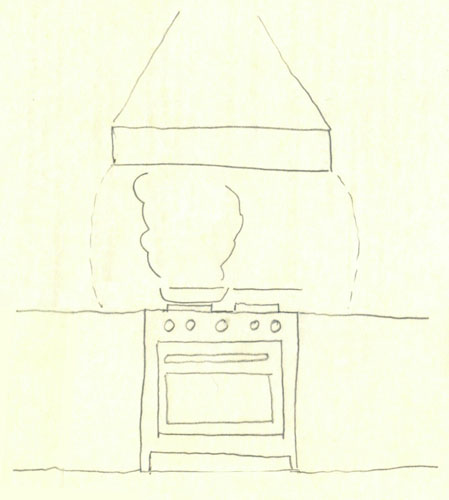
This is a properly sized hood from the front, with the frying pan.
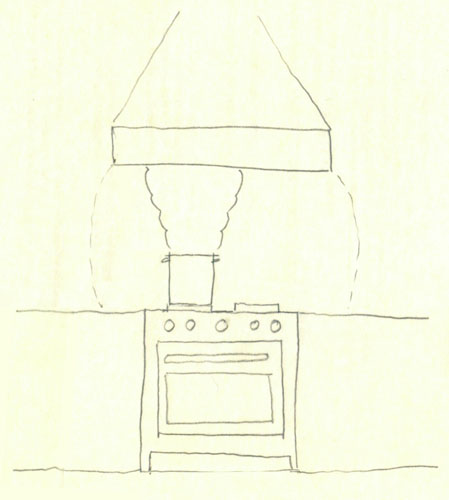
Here it is with the stock pot.
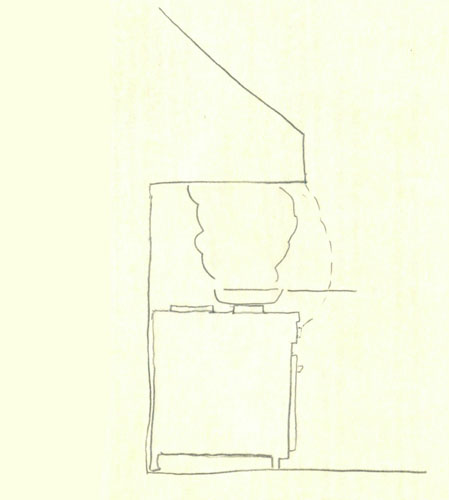
And from the side, you can see the difference the full depth hood makes. If the hood is the right size, you can use any burner fully without filling your home with moisture and bits of oil.
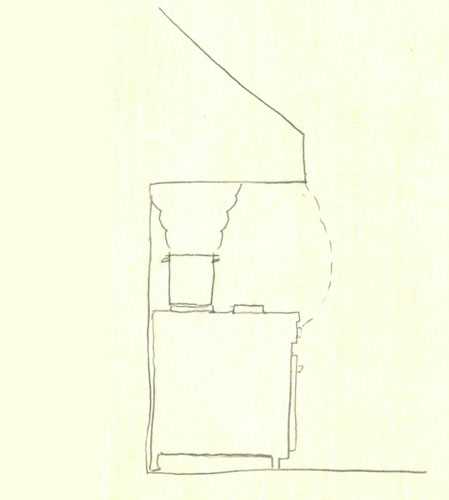
For really moisture-intensive things like making stock or boiling gallons of water for any reason, you should still use the back burners, of course.
OK, so what about islands? Island cooking requires a hood, of course. Ideally it will be hanging down to the right height, and will be wider than the cooktop and just as deep, much as the wall-mounted style. There are also, in ultra-modern spaces or where you really, really cannot emotionally handle a hanging hood, a couple of models of hood that are flush-mounted at ceiling height. You need to be able to get the vent duct out of there and you need the ceiling depth to install them (we usually put them into a slightly lowered soffit over the island), but they exist. Don't use them if you grill.
Which brings me to a brief rant about islands.
I don't approve of using them for cooking or for sinks.
- Venting is more difficult than it should be and will not be as effective as on a wall
- Island worktops are a great place to spread out and work unless you have cluttered them up with stoves and sinks and all the stuff you could better put on the narrower and less useful wall counterspace
- You have a fantasy idea of standing there cooking and talking to your friends and family like you are part of the conversation. You can do this while working on a stove that is behind you and not risk burning anybody who drunkenly leans forward to tell you a great story about their coworker
- Getting plumbing to islands for sinks is a pain in the butt, FYI
Every professional cook I know who has an island either thought it out and kept the island top bare and uncluttered to use for working, or didn't and regrets it. The way working kitchens are laid out is that the cooking and washing appliances are against the walls and the work surfaces are in the center of the room. It works really well for fast, efficient cooking that is not too dangerous to the people involved. Keep that in mind.
OK, back to hoods.
Here's the classic undersized hood that looks right but doesn't fit:
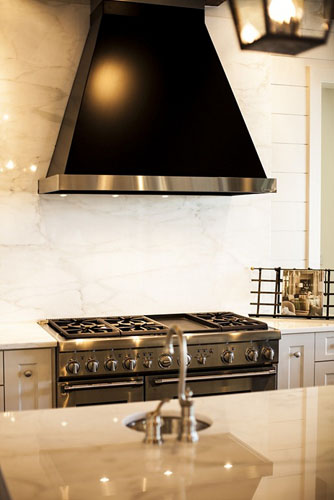
(From here.) This is a really pretty design, nice and open and a great showcase for an expensive range and a pretty pricey hood. But ranges like this come with specifications that tell you to get a hood sized at least 6" wider than the range itself, so this is clearly undersized.
That is OK, again, if you mostly just heat things up and cook moderately, and the stove is mostly for show. I get that. It's maybe not the decision I would make, to spend that much on a stove like this if you aren't planning to use it all regularly, but I get spending money on beautiful things.
I think one reason why people are reluctant to size their hoods properly is that a large hood costs a lot of money. A hood for a 36" commercial-style range can cost you $2000 retail (some appliance stores will sell it to you for less if you also buy the range from them). Sizing down gets you more storage space (people always want more storage space) and saves you a couple hundred dollars. Until you have to replace a bunch of drywall and trim because of condensation issues, of course, but most people don't realize how much moisture cooking puts out.
The next few images are from Vent-a-Hood. While there are a lot of hoods shown on that site that are clearly undersized for the range they sit over, there are also some that are either oversized (perfectly fine) or correctly sized.
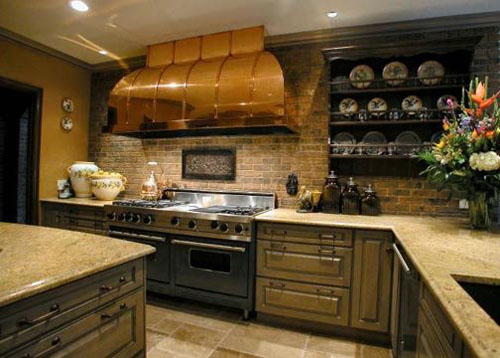
This one gives you an idea of why people don't use correctly sized hoods. They are LARGE. For this design they played up the size of the hood by doing it in copper and setting it apart from the cabinets, and it works, sort of, though I'm not crazy about the shiny copper look.
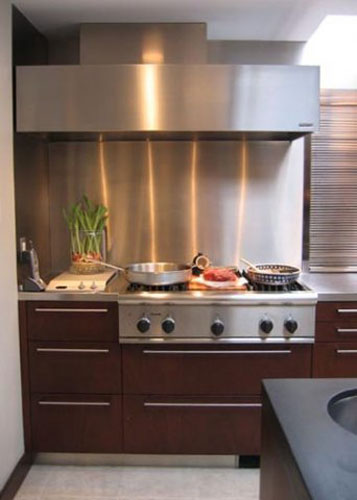
This has a more modern look, and the hood is technically oversized even though it doesn't have perfect placement over the stove. Because of the way hot air moves, that is not going to help on the right side of this stove, but that may be a tradeoff the homeowners were willing to make (though to be honest I don't think many designers offer that as a tradeoff; I find designers to be mostly focused on appearance rather than function).
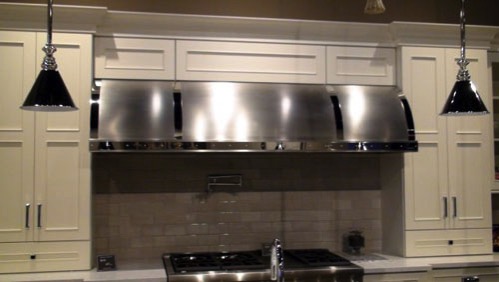
And finally, this is not a good design but it shows you an oversized hood. There's just too much stuff going on here in this design, like each individual part was chosen separately instead of to produce one coordinated effect, and the lighting is terrible. On the other hand, if they decide to have seven friends over to make marmalade one weekend, this hood is up to the task.
I've pretty much finalized the elevations and material lists for our kitchen and pantries now, so maybe I will get together a post on that in the next week.
posted by ayse on 02/07/16